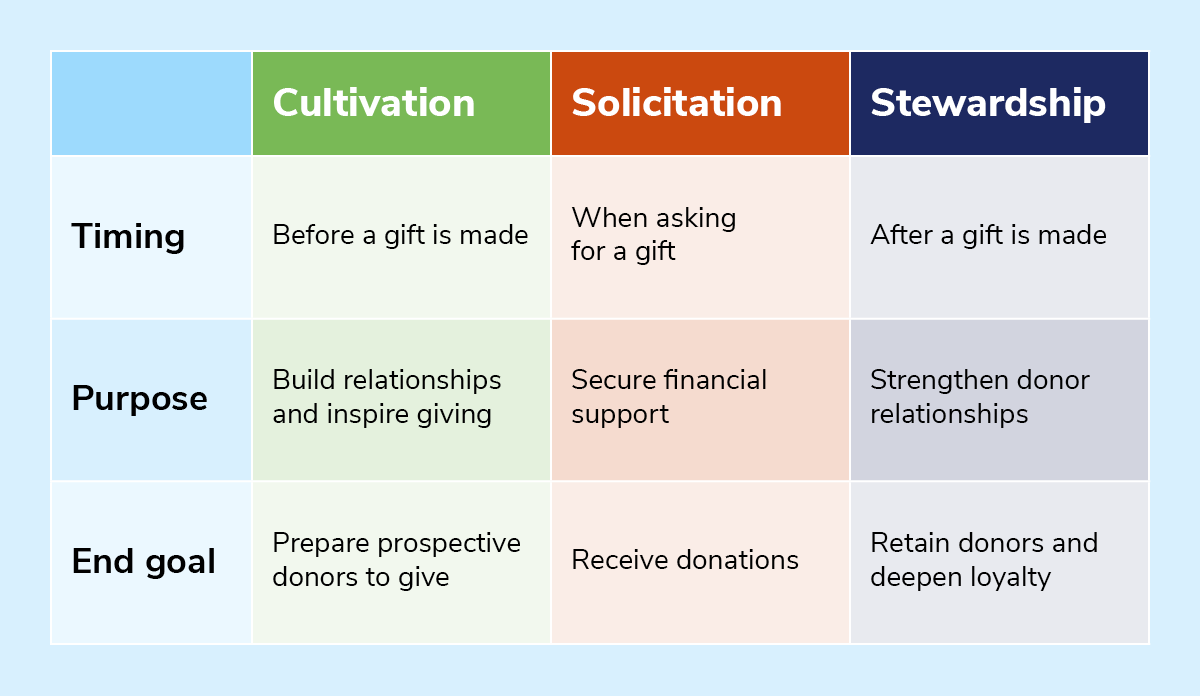
Your nonprofit’s mission and fundraising success are interdependent—one cannot exist without the other. Supporters donate because they believe in your mission, and you can only fulfill your mission using donors’ funds.
That’s why a growing donor base is critical to your long-term success. Expanding your reach is about more than simply increasing revenue; it’s about strengthening your nonprofit’s resilience with a broad network of committed supporters.
We’ve all heard similar strategies proposed for reaching more donors, such as posting on social media and encouraging peer-to-peer fundraising. In reality, growth requires strategic fundraising approaches paired with thoughtful relationship-building efforts.
Let’s review four ways your nonprofit can achieve this balance and expand its donor base.
1. Revamp Your Prospect Research
Insights gleaned from prospect research can help your nonprofit upgrade donors or engage completely new supporters. However, in the age of automation and artificial intelligence (AI), there are innovative ways to identify potential donors and ask for their support.
For your nonprofit, this means it’s time to revisit your current prospect research strategy and consider new ways to learn about donors. Look for new:
- Channels: While traditional prospect research focuses on wealth screening and giving histories, there are myriad channels your nonprofit can use to learn about potential donors. For example, monitor obituaries to identify potential estate gifts or memorial funds. Or, check local news outlets to learn about community leaders or business owners who align with your nonprofit’s cause.
- Networks: The strongest connections are built upon commonalities, such as shared opinions, experiences, or friends. Learn about supporters’ families, friends, and professional associates to identify potential supporters who are already (indirectly) connected to your mission.
- Workflows: Prospect research shouldn’t be a one-time effort—but it shouldn’t be too time-consuming, either. Streamline your workflows by establishing a system for continuous monitoring, like automated news alerts. Media monitoring services for nonprofits can track news mentions of key individuals with giving potential and automatically deliver donor intelligence to your inbox.
The right prospect research software should make it easy for your nonprofit to access these channels, networks, and workflows. Whatever strategies you decide to use for prospect research, ensure your chosen software can achieve necessary tasks and update with important information automatically.
2. Build Strategic Partnerships
In addition to your supporters’ social circles, access new audiences via strategic partnerships with other organizations. Through corporate philanthropy, nonprofit collaborations, and other partnerships, you’ll receive the support of another organization and its audience.
Here are some partnerships you should prioritize:
- Businesses: Double the Donation’s analysis of corporate philanthropy trends reveals that the number of small and mid-sized businesses supporting nonprofits is growing rapidly—94% of major U.S. corporations plan to increase or maintain their current level of philanthropy in the next few years. In other words, there’s a high chance your nonprofit could secure corporate support if you pursue sponsorships and workplace giving programs.
- Influencers and thought leaders: With the rise of social media, like-minded individuals are increasingly advocating for causes and organizations on their personal platforms. Partnering with influencers and industry thought leaders can help your nonprofit tap into their significant followings.
- Community organizations: Schools, churches, service clubs, and other community organizations often align with nonprofit missions and, as a result, are deeply engaged in philanthropy. Establish relationships with these organizations by attending public meetings, collaborating on service projects, and researching funding opportunities.
Both your nonprofit and its partners should receive value from the proposed collaboration. In addition to financial support, strategic partnerships should enhance your marketing efforts and credibility, since trusted individuals and organizations will advocate for your nonprofit. On the other hand, corporations will realize positive brand association when they dedicate resources to your mission, and like-minded individuals and organizations can champion a meaningful cause.
3. Lead Donors From Cultivation to Stewardship
While your nonprofit should invest significant resources into identifying potential donors and connecting with new audiences, these are only the early stages of securing long-term support. Your nonprofit must develop authentic relationships with existing and potential donors over time.
You’re likely already familiar with common tactics for doing so: cultivation, solicitation, and stewardship. Insightful Philanthropy’s donor cultivation guide explains their differences this way:

- Cultivation: Before a gift is made, cultivation involves relationship-building with the end goal of preparing prospects to give.
- Solicitation: The actual act of asking for a gift is called solicitation, through which your nonprofit secures financial support.
- Stewardship: After prospects officially become donors, stewardship is the process of strengthening your relationships with them to retain their support and deepen loyalty.
Effective donor acquisition and retention involves all three of the above steps—in other words, your nonprofit should view this as a cycle or a process rather than a static strategy to engage a segment of supporters.
After identifying individual prospective donors or partners, cultivate the relationship by informing them of your mission, inspiring them to support your cause, and inviting them to get involved. Once prospects respond to your call to action, continue investing in your nonprofit’s relationship with them. This could include demonstrating your impact and showing your appreciation for their support.
4. Optimize Your Outreach and Messaging
Your thorough research and innovative marketing tools will only provide value if your outreach is effective. In order to expand your audience, you must capture their attention and compel them to take action through your messaging. And, much like prospect research, outreach optimization isn’t a one-time process.
Here are a few ways you can continually refine your outreach strategies:
- Split or A/B testing: Experiment with different versions of your content by varying your messages to different audiences. Consider varying visuals, storytelling techniques, email subject lines, and other elements across channels. Then, assess your audience’s responses to determine which approach works best.
- Segmentation: Instead of segmenting donors according to their demographic data or giving behaviors, hone in on more personal characteristics. Analyze psychographic donor data to learn about their hobbies, interests, and lifestyles. Perhaps you’ll group donors together who seem more adventurous or enjoy going to the gym to promote a charity fun run. These small details can find a place in your messaging and help donors feel like you truly know them.
- Personalization: Avoid generic personalization strategies, like addressing a donor by their first name or mentioning the dollar amount of their last gift. Instead, use the personal data described above to help donors feel personally known and recognized by your organization. For example, perhaps you learn through a donor news alert service that the brother of a long-time supporter recently passed away. In this case, you could send your condolences in a handwritten card and a bouquet of flowers to the family.
Remember that continuous monitoring is the best way to keep up with what’s going on in your supporters’ lives. Responding accordingly, especially to big life changes, can significantly impact those who support your cause.
While reaching new audiences is always a focus for nonprofit organizations, it’s important to avoid treating the relationship as a transaction. After all, donors are more than just funders for your mission—they’re the people behind the change your organization wants to see in the world.